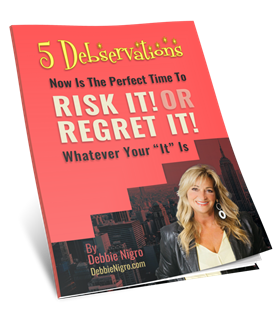I’ve always admired hydrangea flowers but this year I was obsessed! I was slamming on my brakes and jumping out of my car just to take pictures of ‘other people’s hydrangeas’!

It’s not like I’d never seen hydrangeas before. It’s just that this year for some reason they just seemed more beautiful than I ever remember. Especially the blue and purple ones.
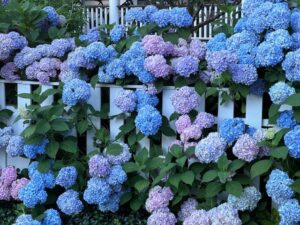
I wanted to share in the hydrangea joy, so I went and bought a pretty blue and purple hydrangea plant at Home Depot. I think it died in the car on the way home. I planted other pretty flowers that lived to make me proud, but sadly not that one. I was bummed.
Apparently my dead hydrangea sparked my very severe case of “hydrangea envy’.
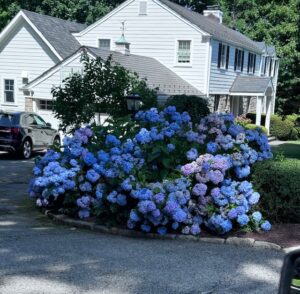
Every time I’d spot a house with gorgeous hydrangeas I’d somehow on foot or by car, get up close or back up close, and whip out my phone to take a picture.
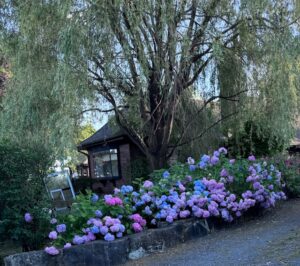
I now have a ridiculous number of ‘other people’s hydrangeas’ photos in my phone.
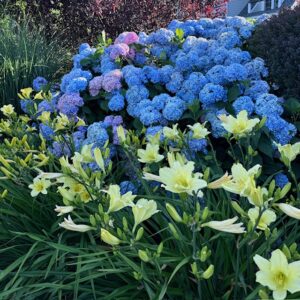
I thought it was just me until I had lunch with a business pal and mentioned my ‘Hydrangea Envy Problem’ and he whipped out his phone with the same number of Hydrangea photos! That was a really good belly laugh.
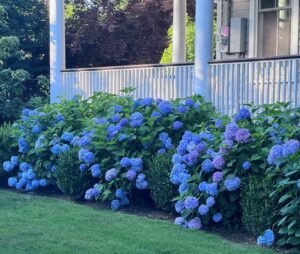
We both really wanted to know ‘why’ suddenly, this year, were these plants so much more amazing?
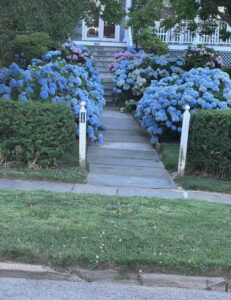
We decided we needed to find a ‘hydrangea expert’! So, I went and found ‘the best’ and invited her to join my radio show. Her name is Lorraine Ballato, and she’s truly ‘The Queen of Hydrangeas’.
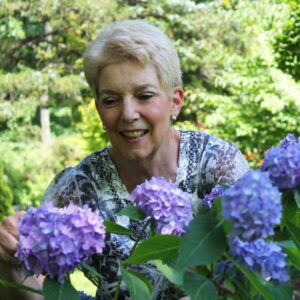
Lorraine is an award-winning writer, speaker, horticulturist, photographer and confirmed plantaholic. She’s written a book called“Success with Hydrangeas’ A Gardeners Guide.” She has tips for knowledgeable and novice gardeners alike on how to grow this favorite garden shrub.Success with Hydrangeas in an international best seller. It’s packed with valuable information like; when and how to prune; when and how to fertilize; when to transplant; how to propagate; and when to water — or not.

I knew Lorraine would have the answer to ‘WHY’ the Hydrangeas were so extra gorgeous this year. Was it all the wild weather?
Lorraine said,
“Well, not this year. Wild weather from one year to the next could be the culprit, but we didn’t have any wild weather. The temperatures were fairly even over the course of the spring. We had a nice, kind of mild winter. We had good rain both in the fall and the winter and the spring, and that’s a trifecta to create exactly what we’re all enjoying.”
“I can tell you from a very weakened memory bank that this is the best year I’ve ever seen in over 20.”
“Even if you get mild winters and even if you get a decent amount of rain, we invariably have those crazy spring temperature swings, you know? And we get those freezes in May or we get a freak late season snowstorm. And so even if you make it through with all the other factors, one of those, all you need is a couple days like that and your buds are gone, absolutely gone.”
“So to have all three happen in the same growing year is rare to say the least.”
Enjoy learning more about the ‘Diva’ hydrangeas and enjoy meeting Lorraine Ballato in this podcast of our live conversation on The Debbie Nigro Show. If you’d rather read than listen the audio transcript is below.
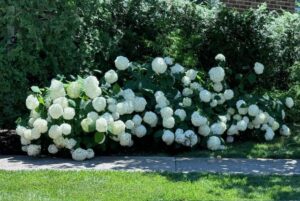

Meanwhile, there’s no need for you to zone out and become envious of ‘other peoples plants’ like I did. You can have your own fabulous plants if you just look into what plant hardiness zone you’re in. Just type your zip code into the USDA Plant Hardiness Zone Map.
AUDIO TRANSCRIPT:
0:00:00
And now, back to the Debbie Nigro Show.
1
0:00:07
Hi guys, Debbie Nigro, welcome back to my show and you know I try to stay relevant with what’s going on in the world. And there’s nothing more relevant to me than trying to figure out why this year all those hydrangeas are like beyond gigantic, gorgeous and colorful because no matter where I’ve been going I look out my window or I pass in the house I’m like my neck snaps. I’m like oh would you look at that? Oh my gosh, it’s beautiful And I told you I pull over and I’m taking pictures and strange people’s houses and surprise. I haven’t gotten Police called on me. I’m like, why is that woman taking the picture? Anyway, I’ve got a collection in my phone
1
0:01:00
Of all these hydrangeas, which I’m gonna post for you guys and in a blog and I’m going to tell you a funny story I happen to be with a buddy of mine who’s a businessperson talking business and I said look I got this hydrangea envy problem. He goes, oh wait, and he shows me his phone, same pictures. So we both laughed out loud and said, we need to find somebody who’s an expert in this and get the word on why. So I found her.
1
0:01:24
Oh, yes, I did. Lorraine Ballato. She’s an award-winning writer, speaker, horticulturist, photographer, and confirmed plantaholic. Who could be better? And she, at the top of her page, which you’re going to see in a second, I’m putting it up now, you’re going to see that she’s a hydrangea expert, just the gal I was looking for.
1
0:01:43
So I invited her on the show. Here she is, Lorraine Bellotto. Hello, Lorraine.
2
0:01:46
Hello, Debbie. Thank you for having me.
1
0:01:49
Oh, we’re just starting our relationship, Lorraine. Everybody wants to talk to you. Everybody who loves hydrangeas is like, can I talk to her? Can I talk to her? I’m serious. One of my people I’m going to turn on to you actually is a backyard design expert, like real high end, and he was like, I really
1
0:02:05
need to talk to her. So you’re going to get some referrals. How you doing Lorraine?
2
0:02:10
I’m doing okay. I’m glad to be inside an air conditioned house right now though. I was out this morning and it was just brutal.
1
0:02:17
How are these plants doing so well with such wild weather? Is the wild weather responsible for the plants doing well?
2
0:02:23
Well, not this year. Wild weather from one year to the next could be the culprit, but we didn’t have any wild weather. The temperatures were fairly even over the course of the spring. We had a nice, kind of mild winter. We had good rain both in the fall and the winter and the spring, and that’s a trifecta to create exactly what we’re all enjoying now. The trifecta. Son of a gun. How often does the trifecta happen in horticultural history? Boy, I couldn’t give you data, but I can tell you from a very weakened memory bank
2
0:02:58
that this is the best year I’ve ever seen in over 20.
6
0:03:03
Right?
2
0:03:04
Even if you get mild winters and even if you get a decent amount of rain, we invariably have those crazy spring temperature swings, you know? And we get those freezes in May or we get a freak late season snowstorm. And so even if you make it through with all the other factors, one of those, all you need is a couple days like that and your buds are gone, absolutely gone. So to have all three happen in the same growing year is rare to say the least.
1
0:03:32
I thought there was something up, Lorraine, and I needed to confirm it with you. So how did you get into this? I mean, how did you become a hydrangea expert? It’s a very difficult plant to master.
2
0:03:43
Well, it is challenging. I worked at White Flower Farm, which is a garden center up in Litchfield. It’s fairly high end. I was there for over 10 or 11 years. I forget how many years, but what would happen is, in dealing with my customers, no matter what they came in, if they were coming in for roses or they were coming in for tomatoes
2
0:04:01
or they were coming in for daylilies. It made no difference. The discussion always wound up with a hydrangea question. And it was all the time, because this is a challenging plant for most people that live where we live. If you lived in the state of Washington, for example, and lived down in Atlanta, you wouldn’t
2
0:04:18
even blink. They don’t have these issues. But because of our climate, we definitely have them. So these people would always wind up with a hydrangea question and it was so continual and I would come back and I would try to do some research and figure out the answers to the questions and there was no one place to get it and so it became a quest if you will on my end and then finally that
2
0:04:38
ended up in a book and a blog and a website and you know the rest.
1
0:04:41
That’s great. What’s the name of your book so everybody can know?
2
0:04:45
The book is Success with Hydrangeas, a Gardener’s Guide and it’s all about how to grow them. It’s not an encyclopedic rundown of the latest and greatest that are in the marketplace. Frankly, if I did that, it would have been obsolete within six months or so many new introductions, but it’s about how you get the best from the plant. What do you need to do differently? You know, this is not a forsythia that you stick in the ground and you walk away.
2
0:05:08
This is a plant that I call it a diva and it really does require that you spend some time and you pay some attention to it.
1
0:05:17
The Diva plant, wow. Okay, I like that little one. So hydrangeas are all over the country?
2
0:05:23
Yes, they are. And some areas, some varieties, you know, there are hundreds of different varieties and so we only see about six where we are and in most other parts of the country. So depending on where you are, you may see more or less of one or the other. The most popular one is the one that gets everybody’s attention, which is the big leaf hydrangea, the one with the big blue pom-pom flower.
2
0:05:48
I call it the elusive blue flower because we don’t see it that frequently. So that’s the one that’s the most popular. It’s the one that’s in the marketplace most frequently. It’s the one the breeders work on most often. But there are several others that are just as beautiful and many are extremely fragrant and much more weather tolerant than the big leaf hydrangea.
1
0:06:10
So the blue hydrangea got into my life because my grandmother, Grandma Nigro, had a big blue hydrangea in the front of the yard and as kids I totally remember every time we’d go there I’d stop and be like, oh, Grandma’s blue hydrangea. Like I associated with her, right? So fast forward all these years, I’ve never been good at keeping plants alive. We’re going to have to spend some time, me and you.
1
0:06:32
I’m a plant killer from way back. But because of my hydrangea envy problem, classified, I decided this year I’m going to try. So I go buy a blue hydrangea at Home Depot. I’m sure I’m not the only person, and it’s in a pot, right? And I bring it like, okay, can’t wait, and it dies on me.
1
0:06:48
Lorraine, it dies. Can it not live in a pot?
2
0:06:52
Well, it depends. If you have purchased one, for example, around Easter or around Mother’s Day, and that was the time frame, usually the pot plants are designed just for living in a pot inside the house where you can enjoy it for the several weeks that the flowers are alive. And then that’s it. They’re bred just to be what they call pot plants. And so if you’ve purchased it at that particular point in time, you most likely got a pot plant. If you purchased it later on, maybe you did, maybe you didn’t.
2
0:07:21
But pot plants are a big business in other places besides the U.S. You go to Europe and the industry is loaded with pot plants and people buy them all year long, again, to put them in the house and just enjoy the flowers. So you might have gotten a pot plant.
1
0:07:38
Ah, jeez. You know, it’s like I show me as an example of what not to do. My picture should be up there at the garden center, like don’t do what she does. So where did the hydrangea come from? What’s the origin? I’m just very curious where it started.
2
0:07:53
Well, the big leaf hydrangeas come from Japan. Usually they come from Asia. Some come from Korea, but predominantly from Japan. And you know, that’s a very mild climate that is an island country. It has the benefit of the warmth and the moisture that the surrounding water provides for it. They come from some, some of them come from the mountains of
2
0:08:13
Japan and those are much more resistant to the weather issues that we experience but they’re mostly coming from Asia and again this is the big leafs. You know there are some hydrangeas that are US natives that are not big leaf hydrangeas. You have an oak leaf hydrangea which is a U.S. native and you have something called an Annabelle for example which is a woodland hydrangea and that’s also a U.S. native but it’s not the big blue flower. And that’s what I say, what everybody really wants to get their hands on.
2
0:08:40
I would just suggest they buy a can of spray paint but they don’t want to do that.
1
0:08:45
Oh my God. So where do you hang your hat? Where are you physically in the world? I’m in Connecticut. I’m over on the
2
0:08:52
western part of the state in Brookfield, not far from Danbury. I have kind of a, you know, if you look on the map, the growing zone would tell you that I’m in growing zone six, but frankly the environment that I have, we’ve got a fairly hilly piece of property and so that topography kind of puts me in a zone five, which makes it a lot harder. A lot of these plants are hardy to zone 6. The plant is hardy, but the stem needs to be hardy to zone 6, and that’s where the challenge comes in. So, as you, we’ve
2
0:09:22
been driving around doing different things, and last week we were up and went up toward the Berkshires. And, you know, you get beyond a certain point, and then you don’t see the blue hydrangeas anymore, because they’re just not going to make it up there, and people don’t buy them. So you get to northern Connecticut, and that’s just about the top where you can really grow these on a good year like we’ve just been experiencing. So they are persnickety relative to weather.
1
0:09:47
Should people be looking at what zone, what horticultural zone, plant zone they’re in when they try and make their houses look beautiful with flowers? Is that important?
2
0:09:57
Absolutely. In all cases, unless it’s an annual like an impatience, you know, or something that you just stick in the ground like a bedding plant. Other than that, if it’s a shrub or any kind of a perennial that’s going to come back year after year, then you should be paying attention to that growing zone.
2
0:10:12
And that’s determined by the United States Department of Agriculture, USDA. And so they put maps out and they just did a revision of it in the map recently where they revised the zones. And so most people, for example, I used to be on the map, I used to be in zone 5. And according to them now I’m in zone 6, but I’m not really because I have this microclimate.
2
0:10:34
But microclimates have a lot to do with whether or not the plants really will make it in the assigned zone that you think you’re in. So paying attention to microclimate is just as important as paying attention to the zone classification.
5
0:10:47
Wow.
1
0:10:48
I don’t know that everybody knows where to find a zone map, Lorraine.
2
0:10:52
You know, it’s really good. You just Google it, you use your favorite search engine, and you just put in USDA zone, and actually it’s an interactive map. You put in your zip code, and it comes back, and it tells you exactly where you are. But again, you have to gauge that. For example, where you are in Greenwich, you’re much milder than we are here, because you have the benefit of the water around you, right?
2
0:11:15
So your winters are not as cold and your summers are not as hot and you have moisture that we don’t have. But once you get inland and you get away from the shoreline, you get away from, for example, where you are in Greenwich or if you’re on the Cape, for example, that’s ideal, but you get to inland Massachusetts
2
0:11:30
and you get to inland Connecticut and the zone completely changes. The plants have a very different experience when they’re away from that maritime environment.
1
0:11:40
Okay, so there’s a beginning and an end to most floral love, right? When something, you know, people, plants come and then they go. My grandkids, I always tell them, in the beginning of spring, the flowers are coming back, the flowers make a big deal about it, and then all of a sudden it’s like, flowers are going away, flowers are going away. Is the hydrangea thing
1
0:11:59
across the country different, that some of them never go away or is it like do they always come and go? What’s the deal?
2
0:12:07
Well it’s a shrub. So it’s classified as a shrub and when you’re classified as a shrub that means you have a woody stem that persists but they are deciduous so they always lose their leaves and they always have to have a rest period where they can recharge so they can put their energy back into producing more flowers. So it’s not like a pine tree, for example, that stays green all year long. Eventually you’ll have sticks and then you keep your fingers crossed. You know, it’s a real gamble. You keep your fingers crossed and hope that come April or
2
0:12:39
May you start to see some life in the plant and then you have to wait a little longer to see the buds emerge. It’s a cycle that takes its sweet time before it shows up. And the buds, they have to, and here’s the tricky part, the buds on the big leaf hydrangeas, which is the one we’re talking about, they are set in the fall of this year for next year. And so those buds have to live through the vagaries of our crazy winter before they’ll give you a flower. And that’s where the challenge comes in. You know, some of the hydrangeas don’t put the buds on until the beginning of the current year and those are absolutely foolproof.
2
0:13:18
If you can’t grow one of those you should take up golf because they’re really foolproof.
1
0:13:22
I’m seeing golf in my future Lorraine’s, not good. I’m just going to ask you, can you revive a hydrangea, like say if one looks good and the rest behind them are all looking dead, not that I have one that looks exactly like that but I do.
2
0:13:36
It depends on what’s going on. You know, I mean, if it looks kind of dead because it’s starved for water, then you want to give it a drink. But it could be dead, you know, because maybe you have a critter, maybe you have a deer, you know, something that’s been decided it wants to eat it. And so there’s all kinds of reasons for it to look.
2
0:13:57
That’s why you need to have a relationship with a garden center. Or you go to the local Master Gardener office, you go to the local UConn Extension office and you take your sample in. Or you can actually email photographs and we’ll respond and we’ll tell you what we think it is based on the information that you’ve shared with us.
4
0:14:13
So we can give you some kind of diagnosis.
1
0:14:14
Okay, I just have you. To heck with everybody else. I’m sticking with you, Lorraine Ballato. You are the queen, the queen of flowers and all things that need to live and look beautiful. All things hydrangea is just one section of your site, which I thought was terrific. And I’m so pleased to meet you.
1
0:14:31
You’re wonderful on the air and got great presence. And so nice of you to take the time to help us out with this, okay? And you come back sometime, okay?
3
0:14:41
Yep.
2
0:14:42
And thank you for all the positive feedback. It always helps when I’m plugging away to know that there’s an ear listening somewhere.
1
0:14:47
Yeah, that’s great. She has a Success with Hydrangea’s book. Her website is LorraineBallato.com. Her website is LorraineBallato.com. Award-winning writer, speaker, horticulturist, photographer, and confirmed plantaholic.
Transcribed with Cockatoo



